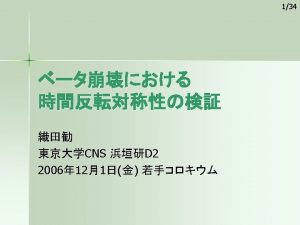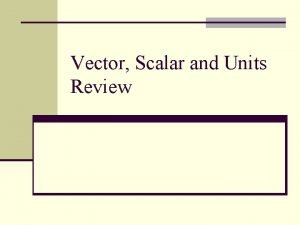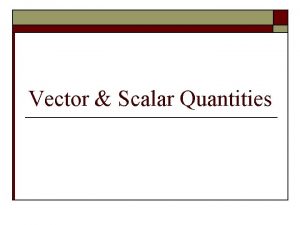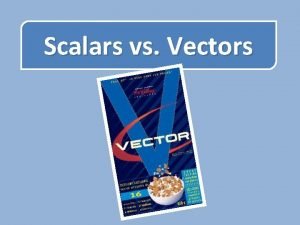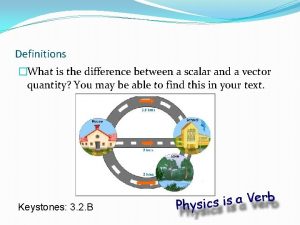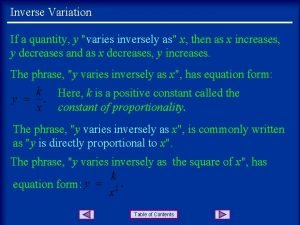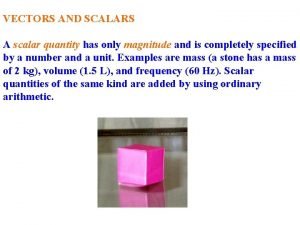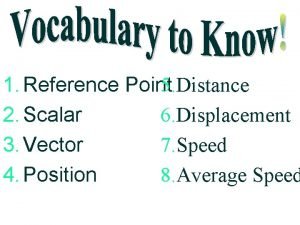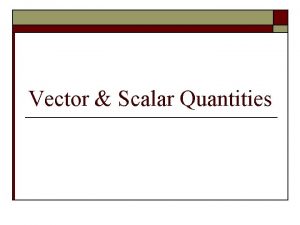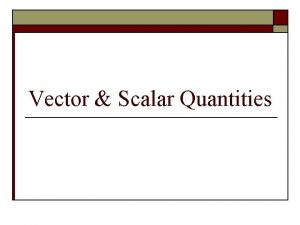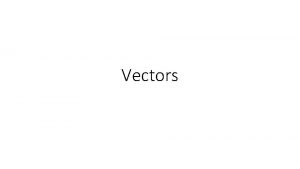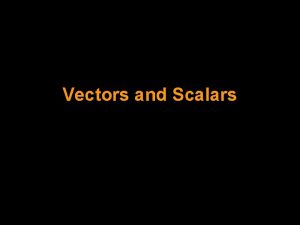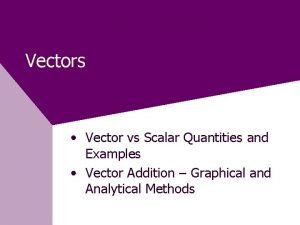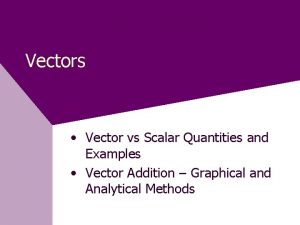Vector v Scalar quantities Scalar Vector A quantity














- Slides: 14

Vector v Scalar quantities Scalar Vector • A quantity which is fully described by magnitude (size) alone • A quantity which is fully described by both magnitude and a direction A car is travelling at 30 mph in a north-easterly direction This gives us information on the magnitude (or speed) of the car, but no info on direction We now have information on its magnitude and its direction

Mass V Weight Mass Weight • Mass is the quantity of matter a body possesses. • The greater the matter, the bigger the mass. • A shot putt has a greater mass than a table tennis ball as it is greater in density and volume • Mass of an object always remains the same at any place • Scalar quantity as no direction • Weight is the force exerted on the mass of the body by gravity • If you go to the moon, your mass remains the same (e. g. 60 kgs), but your weight becomes less by 1/6 since the moons gravity is 1/6 of the earths. • Weight is a force, measured in Newtons • As weight always acts downwards and has a magnitude it is therefore a vector quantity

Inertia • The reluctance of the body to move or change its state of motion • The bigger the mass of an object the harder it is to move and therefore the greater the quantity of inertia • Moving objects or bodies that have a high inertia will need a large force to change the state of motion

Distance V Displacement • Distance • Refers to the amount of ground an object covers during its motion • • • 400 m runner who has completed a race. Distance covered is 400 m Start and finish line in the same place therefore the displacement is 0 Displacement Considers how far the position of the object has changed as a result of the motion ‘as the crow flies’

Speed V Velocity • Speed is the rate of change in distance or body’s movement per unit of time and no direction • Speed is a scalar Speed (ms-1) = Distance (m) Time (sec)

Speed V Velocity • Velocity is the rate of change of displacement • It is a vector quantity • When evaluating velocity we must consider direction • EG the car is travelling at 30 mph in a NE direction Velocity (ms-1) = Displacement (m) Time (secs)

Acceleration and Deceleration • • The rate of change of velocity of an object They are direction aware Vector quantity Acceleration is the rate of increase in velocity and deceleration the rate of decrease in velocity

Momentum • Momentum is the amount of motion a body possesses and is the product of mass and velocity • Momentum = Mass (kg) x Velocity (ms-1 ) • Measured in kilogram metres per second (kgms-1 )

Impulse • Another way of describing FORCE • Impulse is concerned with the length of time a force is applied to an object/body and relates to change in momentum that occurs as a consequence • Impulse = Force x Time

Impulse • Impulse is used in sport to: – Add speed to a body or object – Slow down moving bodies slowly on impact • EG a shot putter performs a turn before release does so to maximise the time over which a force is applied to the shot, increasing outgoing acceleration • EG a follow-through is used in racket/stick sports to increase the time the racket/stick is in contact with the ball, which will increase the outgoing momentum of the ball (as well as giving it direction)

Impulse and Sprinting Force-time graphs – The area under this graph is the impulse, and in the graph in figure 7. 9 of the force between foot and ground during a foot strike when sprinting, the bigger the area under the graph, the bigger the impulse, and the greater the change of momentum of the runner (and hence the greater the acceleration and therefore the change of velocity).

• a when the runner is in contact with starting blocks or immediately at the start. • b when he or she is accelerating during the first 2– 3 seconds of a run. • c when the runner is running at approximately constant speed during the middle of a run. • d during the slowing down at the end of a run.


 Scalar vector tensor
Scalar vector tensor All scalar and vector quantities
All scalar and vector quantities Vector quantities
Vector quantities Scalar distance
Scalar distance Scalar units
Scalar units Characteristics of vector quantity
Characteristics of vector quantity Scalar vs vector
Scalar vs vector Centripetal acceleration is a scalar quantity.
Centripetal acceleration is a scalar quantity. Scalar and vector quantity difference
Scalar and vector quantity difference Relation between linear and angular quantities
Relation between linear and angular quantities Y varies inversely as x example
Y varies inversely as x example Scalar quantity has
Scalar quantity has Displacement formula distance
Displacement formula distance Vector quantities measure
Vector quantities measure 30 examples of vector quantities
30 examples of vector quantities
